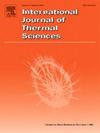Experimental study on nucleate boiling of liquid nitrogen spray cooling on superhydrophilic microstructured surface
IF 4.9
2区 工程技术
Q1 ENGINEERING, MECHANICAL
International Journal of Thermal Sciences
Pub Date : 2025-02-26
DOI:10.1016/j.ijthermalsci.2025.109800
引用次数: 0
Abstract
Cryogenic spray cooling with liquid nitrogen has been gradually applied to the electronic industry and superconducting material cooling. Changes in the wettability and micro/nano-structure of the heat-sink surface can nicely improve its heat dissipation. In this work, three types of surfaces, including a smooth copper surface, a superhydrophilic smooth copper surface, and a superhydrophilic microstructured copper surface, were produced by chemical corrosion and laser etching. The opened spray cooling experiments with liquid nitrogen on these three cooling surfaces were conducted, and the influences of the key parameters were analyzed. The nucleate boiling curves of liquid nitrogen spray cooling on these types of surfaces were obtained. The experimental results show that: the superhydrophilicity of the surface can improve the critical heat flux (CHF) of nucleate boiling in liquid nitrogen spray cooling, and the coupling of the superhydrophilicity and microstructure can better enhance the boiling process, contributing to the delay of CHF's arrival. The maximum CHF of superhydrophilic microstructured surface can reach 181.5W/cm2 at the superheat of 21.8 °C, and the maximum heat transfer coefficient (hMAX) can reach 161330W/m2K. This CHF is 1.92 times that of smooth copper surface. This work will provide ideas for guiding cryogenics cooling applications.
求助全文
约1分钟内获得全文
求助全文
来源期刊

International Journal of Thermal Sciences
工程技术-工程:机械
CiteScore
8.10
自引率
11.10%
发文量
531
审稿时长
55 days
期刊介绍:
The International Journal of Thermal Sciences is a journal devoted to the publication of fundamental studies on the physics of transfer processes in general, with an emphasis on thermal aspects and also applied research on various processes, energy systems and the environment. Articles are published in English and French, and are subject to peer review.
The fundamental subjects considered within the scope of the journal are:
* Heat and relevant mass transfer at all scales (nano, micro and macro) and in all types of material (heterogeneous, composites, biological,...) and fluid flow
* Forced, natural or mixed convection in reactive or non-reactive media
* Single or multi–phase fluid flow with or without phase change
* Near–and far–field radiative heat transfer
* Combined modes of heat transfer in complex systems (for example, plasmas, biological, geological,...)
* Multiscale modelling
The applied research topics include:
* Heat exchangers, heat pipes, cooling processes
* Transport phenomena taking place in industrial processes (chemical, food and agricultural, metallurgical, space and aeronautical, automobile industries)
* Nano–and micro–technology for energy, space, biosystems and devices
* Heat transport analysis in advanced systems
* Impact of energy–related processes on environment, and emerging energy systems
The study of thermophysical properties of materials and fluids, thermal measurement techniques, inverse methods, and the developments of experimental methods are within the scope of the International Journal of Thermal Sciences which also covers the modelling, and numerical methods applied to thermal transfer.
 求助内容:
求助内容: 应助结果提醒方式:
应助结果提醒方式:


